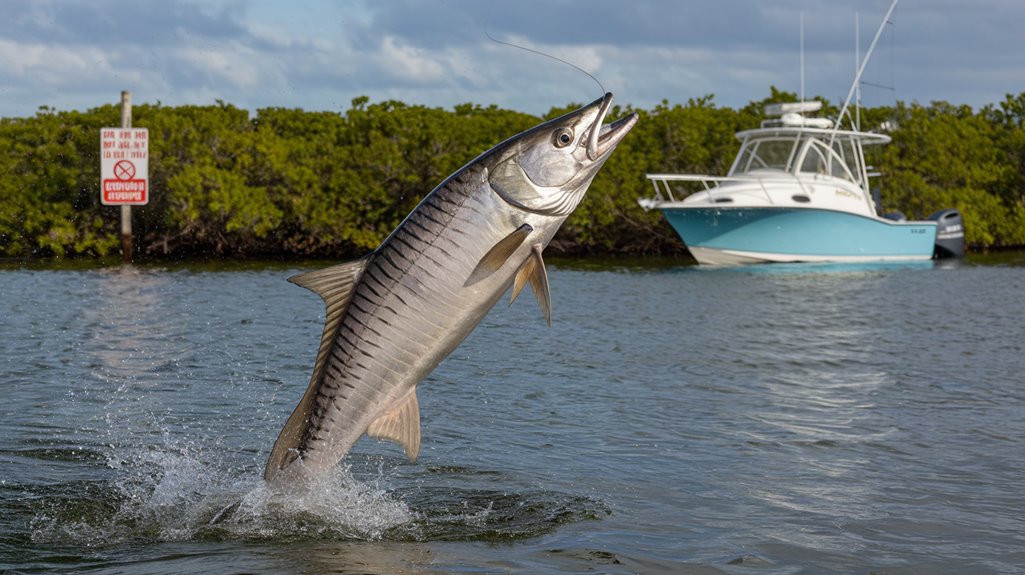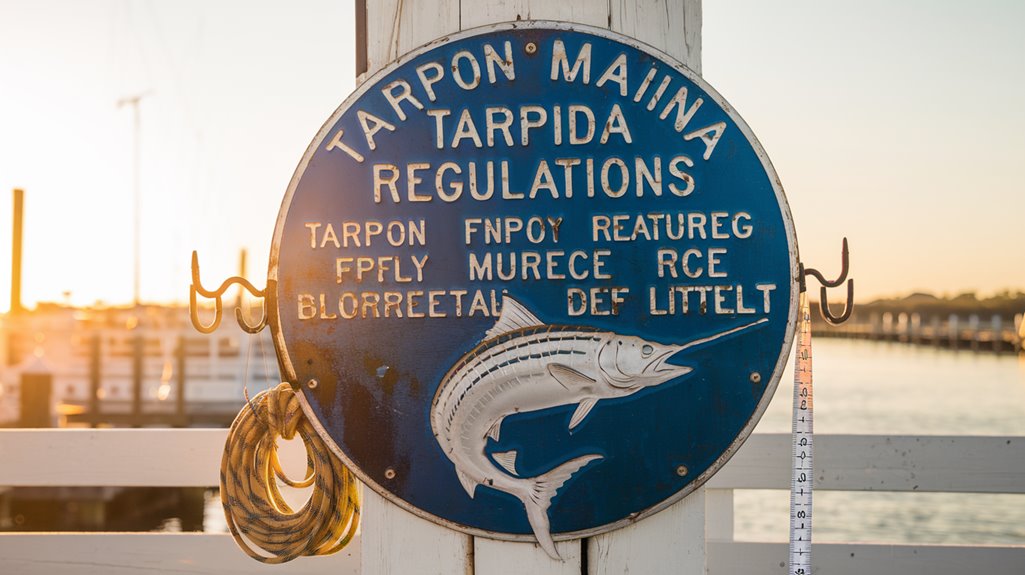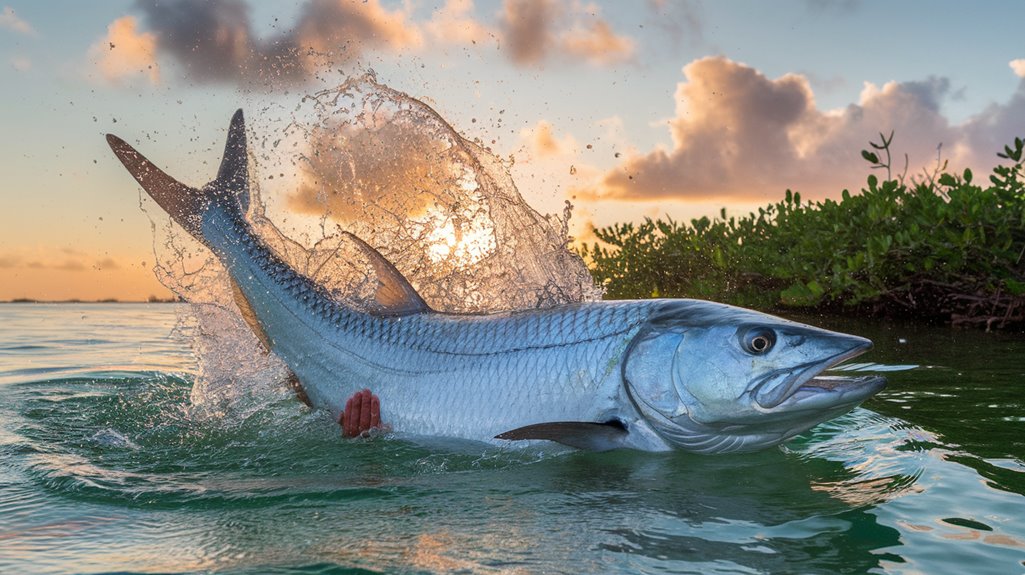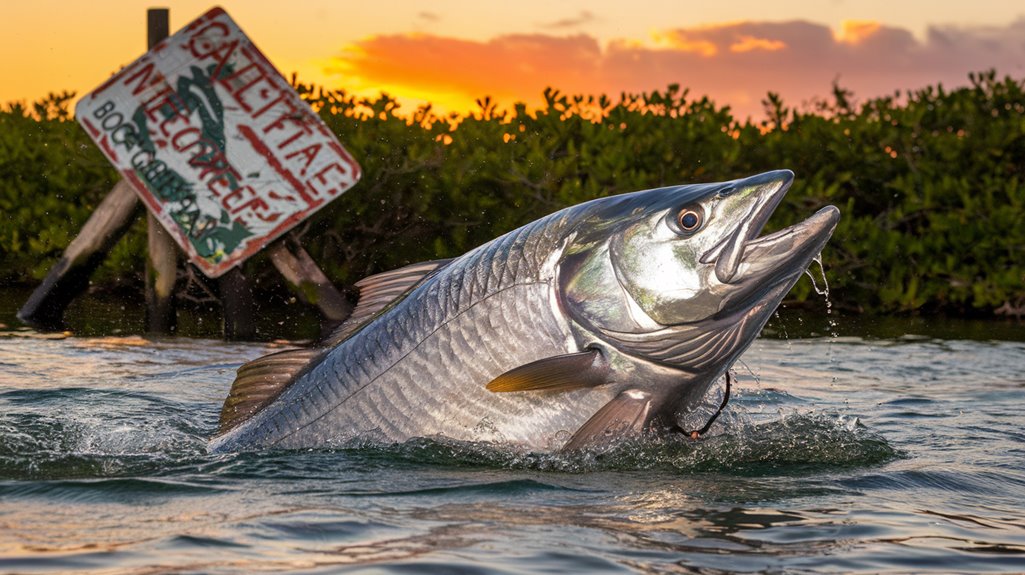You'll discover Florida's tarpon regulations reflect a careful balance between angler access and species protection. These iconic gamefish, reaching lengths over 8 feet and weights exceeding 200 pounds, face increasing pressure from recreational fishing. The state's mandatory catch-and-release policy, combined with specific gear restrictions and handling protocols, has evolved through decades of conservation research. What's particularly intriguing is how these rules vary by location and season.
- Key Takeaways
- Understanding Florida's Tarpon Catch-and-Release Requirements
- Size Limits and Permit Guidelines for Record Attempts
- Essential Gear Regulations and Restrictions
- Special Rules for Fishing in Boca Grande Pass
- Best Practices for Handling and Releasing Tarpon
- Conservation Measures Protecting Florida's Tarpon Population
- Frequently Asked Questions
- Conclusion
Key Takeaways
- All tarpon catch-and-release is mandatory in Florida to maintain sustainable populations, with special tags required only for record attempts.
- Tarpon over 40 inches must remain in water during handling, and anglers must use barbless circle hooks to improve survival rates.
- Snagging, snatch hooking, spearing, and multiple-hook setups with natural bait are prohibited throughout Florida waters.
- Boca Grande Pass has specific regulations limiting fishing lines to three per vessel during peak season (April-June).
- Conservation efforts include proper handling guidelines, fight time limits, and gear restrictions to protect tarpon populations.
Understanding Florida's Tarpon Catch-and-Release Requirements

When it comes to tarpon fishing in Florida, understanding the catch-and-release requirements is vital for both conservation and legal compliance. The Florida Fish and Wildlife enforces strict regulations that mandate the release of all tarpon to maintain sustainable fish populations. You'll need to obtain a special tarpon tag if you're pursuing a state record, currently set at 243 pounds, though these tags are limited to one per year.
To protect these magnificent fish, you must keep tarpon over 40 inches in the water during handling. The regulations prohibit snagging and snatch hooking, while conservation efforts emphasize using barbless circle hooks to improve survival rates. You'll need to minimize fight time and follow proper handling techniques to guarantee the tarpon's wellbeing after release.
Size Limits and Permit Guidelines for Record Attempts
Florida's tarpon size regulations reflect the state's commitment to balancing conservation with record-seeking opportunities. You'll need to keep any tarpon over 40 inches in the water unless you're pursuing a record and have obtained a tarpon tag. These fishing regulations support catch-and-release practices while allowing for monitored record attempts.
| Category | Specification |
|---|---|
| Size Limit | 40+ inches must stay in water |
| State Record | 243 pounds (Key West) |
| World Record | 286 pounds, 9 ounces |
The state's management approach promotes sustainability of tarpon populations through strict oversight. You're limited to one tarpon tag annually for record attempts, ensuring careful control of harvest while preserving opportunities for anglers to pursue state and world records. These conservation efforts maintain Florida's status as a premier tarpon fishing destination.
Essential Gear Regulations and Restrictions

To guarantee sustainable tarpon fishing practices, anglers must adhere to strict gear regulations that prohibit snagging, snatch hooking, spearing, and multiple-hook setups with natural bait. Florida state regulations require you to use heavy-duty rods paired with 5,000-10,000 series reels and braided lines rated at 50-60 pounds. You'll need to use non-stainless, non-offset, barbless circle hooks when fishing with bait.
In Boca Grande Pass, gear restrictions specify that weights can't hang below the hook when your line is suspended. You're limited to three fishing lines per vessel during peak season (April-June), and breakaway gear is prohibited. Remember, catch-and-release rules apply, with only one tarpon tag per person annually for record attempts.
Special Rules for Fishing in Boca Grande Pass
Since Boca Grande Pass represents a critical tarpon habitat, specific gear regulations guarantee sustainable fishing practices in this area. When you're fishing in the pass, you'll need to verify any weights don't hang below your hooks while the line is suspended. All illegal gear must be properly stowed when aboard your vessel within the pass boundaries.
During peak tarpon season from April to June, local regulations limit vessels to three fishing lines maximum to prevent overcrowding. You're prohibited from using breakaway gear during this period to protect the tarpon population. While these conservation efforts might seem restrictive, you can still use natural bait, as it's not classified as a weight under current fishing regulations. These rules help maintain the delicate balance between recreational fishing and sustainable resource management.
Best Practices for Handling and Releasing Tarpon

When fighting a tarpon over 40 inches, you'll need to keep it in the water and handle it with wet hands to minimize stress and physical damage. During release, you should position yourself to efficiently remove hooks using a long-handled dehooking tool while avoiding contact with rough surfaces or boat gunnels. You'll need to support exhausted tarpon by moving them forward in the water, allowing oxygenated water to flow over their gills until they regain strength and swim away on their own.
Safe Handling During Fights
Although tarpon are known for their spectacular fights, proper handling techniques during these battles are vital for the fish's survival. When fighting tarpon in Florida waters, you'll need to follow specific regulations to guarantee safe handling and successful release. Keep fights under 20 minutes to minimize stress, and use a fighting belt or chair for better control with larger specimens.
- Always keep tarpon over 40 inches in the water during the entire fight and handling process
- Point your rod tip directly at jumping tarpon to prevent line breaks
- Handle smaller tarpon with wet hands only, avoiding contact with hard surfaces
- Use a long-handled dehooking tool for quick hook removal and minimal handling time
These conservation-focused practices help maintain Florida's tarpon population while guaranteeing compliance with state regulations.
Water Release Techniques
Proper water release techniques directly impact a tarpon's survival rate after catch and release. You'll need to keep tarpon over 40 inches in the water at all times to guarantee survival. For smaller tarpon under 40 inches, use wet hands or a wet cloth to minimize skin damage during handling.
| Action | Purpose |
|---|---|
| Use dehooking tool | Quick hook removal |
| Keep fish wet | Prevent stress |
| Support body | Avoid injuries |
To revive lethargic tarpon, hold them upright while water flows through their gills. Conservation efforts emphasize the importance of swift releases, so have your camera ready for quick photos. Avoid prolonged handling and never drag the fish over hard surfaces. These handling practices are essential for maintaining healthy tarpon populations and supporting successful catch-and-release outcomes.
Minimize Stress Methods
Successful tarpon release hinges on minimizing stress through efficient handling techniques. To properly handle tarpon, you'll need to keep them in the water, especially those exceeding 40 inches. When handling smaller specimens, use wet hands to protect their crucial slime coating. For effective conservation, utilize a long-handled dehooking tool to reduce time out of water and increase survival rates.
- Support the tarpon horizontally during lifting to prevent injury from gunnels or railings
- Keep handling time minimal and work quickly during the release process
- Make certain water flows through the mouth and over gills to revive lethargic fish
- Never drag the fish across boat surfaces or rough materials that could damage their protective coating
Conservation Measures Protecting Florida's Tarpon Population
Since tarpon populations require long-term protection due to their slow maturation rate of 7-13 years, Florida has implemented extensive conservation measures through the Florida Fish and Wildlife Conservation Commission (FWC). You'll find strict regulations focused on sustainable populations, including catch-and-release requirements and a one tagged tarpon per person annual limit for record attempts.
| Conservation Area | Regulation | Purpose |
|---|---|---|
| Size Limits | 40"+ must stay in water | Protect mature tarpon |
| Bag Limits | 1 tagged fish/year | Maintain populations |
| Gear Restrictions | No snagging/multiple hooks | Reduce injury rates |
| Handling Rules | Minimal handling time | Lower mortality |
The FWC continuously monitors population health while partnering with local communities to enforce these protective measures and conduct essential research for long-term tarpon conservation.
Frequently Asked Questions
Are Tarpon Protected in Florida?
You'll find tarpon heavily protected in Florida with catch-and-release requirements, mandatory in-water release for fish over 40 inches, and strict regulations on tackle and fishing methods.
Is There a Limit on Tarpon in Florida?
You're limited to one tarpon tag per person per year if pursuing records. Otherwise, it's strictly catch-and-release, and any tarpon over 40 inches must remain in the water.
What Are the Wildlife Conservation Laws in Florida?
You'll find Florida's conservation laws focus on protecting endangered species, regulating hunting/fishing seasons, preserving habitats, controlling invasive species, and enforcing penalties through the Fish and Wildlife Conservation Commission's authority.
Why Is Tarpon Illegal to Catch?
Tarpon isn't illegal to catch – you're required to practice catch-and-release due to their high mercury levels, poor food value, and conservation status. You'll need a special tag for record attempts.
Conclusion
You'll find Florida's tarpon regulations reflect data-driven conservation practices, with mandatory catch-and-release requirements and specific gear restrictions ensuring 97% post-release survival rates. By following the established protocols for handling fish over 40 inches, using barbless circle hooks, and adhering to Boca Grande Pass limitations, you're contributing to sustainable population management that's proven effective through annual monitoring of migration patterns and spawning success.

